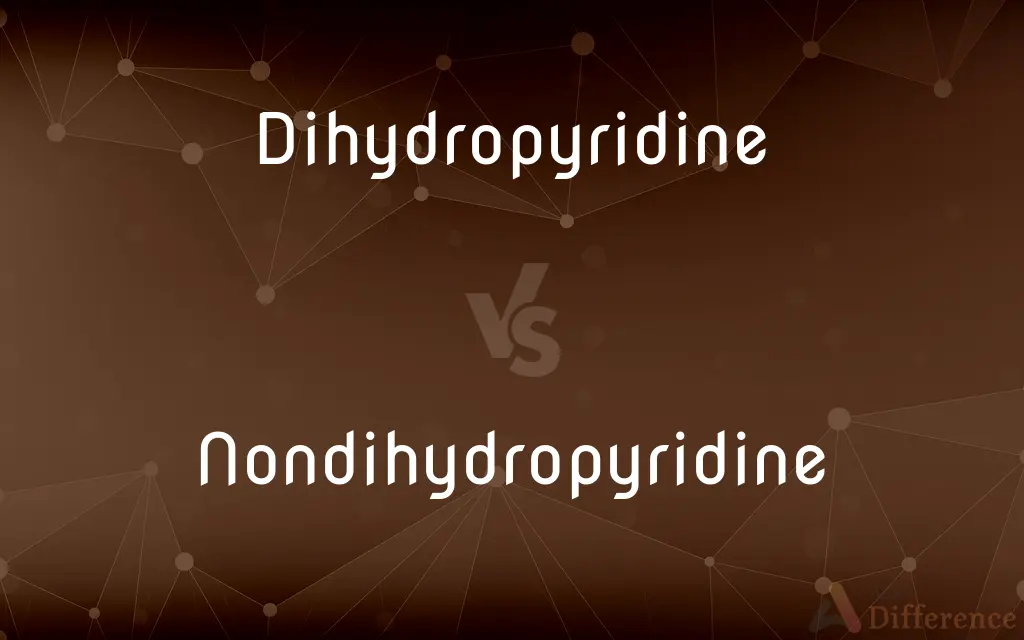Dihydropyridine vs. Nondihydropyridine — What's the Difference?
By Fiza Rafique & Maham Liaqat — Published on October 15, 2024
Dihydropyridines are calcium channel blockers primarily affecting vascular smooth muscle, leading to vasodilation, while nondihydropyridines affect both the heart and blood vessels, offering heart rate control.

Difference Between Dihydropyridine and Nondihydropyridine
Table of Contents
ADVERTISEMENT
Key Differences
Dihydropyridines (DHPs) are a class of medications that selectively target the L-type calcium channels of vascular smooth muscle, promoting vasodilation and thereby reducing blood pressure. This makes them particularly useful in treating hypertension and angina. Nondihydropyridines (non-DHPs), on the other hand, act on calcium channels in the heart as well as in the vascular smooth muscle. This dual effect allows them to not only lower blood pressure but also decrease heart rate, making them beneficial for conditions requiring heart rate control, such as arrhythmias.
DHPs are known for their potent vasodilatory effects without significantly affecting cardiac contractility or heart rate, which distinguishes them from non-DHPs. Non-DHPs, like verapamil and diltiazem, can directly affect the heart's conduction system and myocardium, reducing heart rate, force of contraction, and conduction velocity. This makes non-DHPs useful in treating conditions where reducing the heart's workload is beneficial, such as in certain types of angina and arrhythmias, while DHPs are preferred when the primary goal is to lower blood pressure.
The side effect profiles of these two classes also differ due to their mechanisms of action. DHPs may cause peripheral edema, flushing, and dizziness as a result of their strong vasodilatory effects. In contrast, non-DHPs can cause bradycardia, constipation (particularly with verapamil), and dizziness, reflecting their broader action on the heart and blood vessels.
DHPs, including drugs like amlodipine, nifedipine, and felodipine, are often used when a significant reduction in blood pressure is desired without reducing heart rate. Non-DHPs, due to their effect on the heart rate, are chosen for patients who may benefit from both blood pressure reduction and heart rate control, such as those with certain forms of heart disease.
In clinical practice, the choice between DHP and non-DHP calcium channel blockers is influenced by the patient's specific cardiovascular profile and the therapeutic goals. For instance, DHPs might be preferred in patients with hypertension without heart failure, while non-DHPs could be more suitable for patients with supraventricular tachycardia or in need of heart rate reduction.
ADVERTISEMENT
Comparison Chart
Target
Vascular smooth muscle
Heart and blood vessels
Primary Effect
Vasodilation
Heart rate reduction, vasodilation
Use
Hypertension, angina
Arrhythmias, hypertension, angina
Heart Rate Impact
Minimal
Decreases heart rate
Common Examples
Amlodipine, Nifedipine
Verapamil, Diltiazem
Side Effects
Peripheral edema, flushing
Bradycardia, constipation
Mechanism of Action
Selective to L-type calcium channels in vascular smooth muscle
Affects L-type calcium channels in the heart and vascular smooth muscle
Clinical Considerations
Preferred for lowering blood pressure without affecting heart rate
Used when heart rate control is also desired
Compare with Definitions
Dihydropyridine
Used primarily in hypertension and angina.
Dihydropyridines are chosen for their efficacy in lowering blood pressure.
Nondihydropyridine
Can decrease heart rate and force of contraction.
Diltiazem is beneficial for patients needing reduced heart workload.
Dihydropyridine
Causes peripheral edema and flushing as side effects.
Peripheral edema can be a common side effect of felodipine.
Nondihydropyridine
Useful in treating arrhythmias and hypertension.
Non-DHPs are preferred for conditions requiring heart rate control.
Dihydropyridine
Calcium channel blockers focusing on vasodilation.
Amlodipine is commonly prescribed for its potent antihypertensive effects.
Nondihydropyridine
Affect both the heart and blood vessels.
Verapamil is used for its dual action on the heart and vascular system.
Dihydropyridine
Known for minimal effects on heart rate.
Patients on DHPs like nifedipine rarely experience changes in heart rate.
Nondihydropyridine
Side effects include bradycardia and constipation.
Patients on verapamil may experience constipation as a side effect.
Dihydropyridine
Selectively targets vascular smooth muscle.
The selectivity of DHPs ensures focused treatment of hypertension.
Nondihydropyridine
Offers blood pressure reduction and heart rate control.
The dual effect of non-DHPs makes them versatile in cardiac therapy.
Dihydropyridine
A molecule based upon pyridine, the parent of a class of molecules that have been semi-saturated with two substituents replacing one double bond.
Nondihydropyridine
That which is not a dihydropyridine.
Common Curiosities
Why might a doctor prescribe a Nondihydropyridine?
For patients needing both blood pressure reduction and heart rate control, particularly with arrhythmias or certain types of angina.
What distinguishes Dihydropyridines from Nondihydropyridines?
DHPs primarily cause vasodilation, whereas non-DHPs affect both the heart rate and blood vessels.
What are common side effects of Dihydropyridines?
Common side effects include peripheral edema, flushing, and sometimes dizziness.
Are Nondihydropyridines used for blood pressure management?
Yes, non-DHPs can manage blood pressure and are particularly useful when heart rate control is also desired.
What is a common Nondihydropyridine medication?
Verapamil and Diltiazem are well-known non-DHP medications.
How do Nondihydropyridines help with arrhythmias?
They slow the electrical conduction and reduce heart rate, stabilizing the heart rhythm.
Can Nondihydropyridines be used in all types of angina?
They are particularly useful in certain types of angina that benefit from reduced heart rate and workload, but not all; physician guidance is necessary.
What should I do if I experience side effects from these medications?
Report any side effects to your healthcare provider, who can adjust your treatment plan accordingly.
Are there conditions where Dihydropyridines are preferred?
DHPs are preferred in treating hypertension and angina where heart rate reduction is not necessary.
Can Dihydropyridines affect the heart rate?
DHPs generally do not significantly affect the heart rate, focusing instead on vasodilation.
Can I switch from a Dihydropyridine to a Nondihydropyridine on my own?
No, any change in medication should be done under the guidance of a healthcare professional.
How do Nondihydropyridines affect heart conduction?
They can slow down heart conduction, beneficial in treating arrhythmias and reducing the heart's workload.
Do Dihydropyridines have any contraindications?
Yes, like all medications, DHPs have contraindications, such as severe hypotension or known hypersensitivity to the drug.
Is peripheral edema a serious side effect of Dihydropyridines?
While common, peripheral edema can be managed with dose adjustments or adding other medications; consult a healthcare provider for advice.
Are there dietary restrictions while taking these medications?
Some medications may have interactions with certain foods or supplements; it's important to discuss dietary restrictions with your healthcare provider.
Share Your Discovery

Previous Comparison
Right To Buy vs. Right To Acquire
Next Comparison
Tarantulas vs. SpidersAuthor Spotlight
Written by
Fiza RafiqueFiza Rafique is a skilled content writer at AskDifference.com, where she meticulously refines and enhances written pieces. Drawing from her vast editorial expertise, Fiza ensures clarity, accuracy, and precision in every article. Passionate about language, she continually seeks to elevate the quality of content for readers worldwide.
Co-written by
Maham Liaqat












































